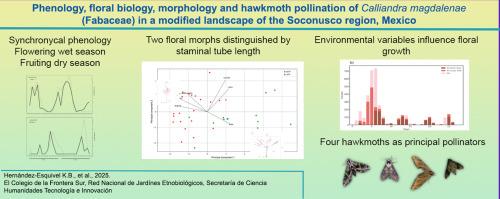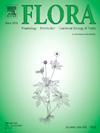Phenology, floral biology, morphology and hawkmoth pollination of Calliandra magdalenae (Fabaceae) in modified landscapes of the Soconusco region, Mexico
IF 1.8
4区 生物学
Q3 ECOLOGY
引用次数: 0
Abstract
Despite the recognized importance of nocturnal pollinators, studies focusing on nocturnally pollinated plants remain limited. Calliandra magdalenae (Fabaceae) is a species that exhibits floral morphology adapted to hawkmoths. The principal aim of this study was to determine the phenological patterns, whether the species reproduces in rural environments, and how climatic conditions influence their floral growth. For two years, the reproductive phenology of C. magdalenae was studied. Flower morphology was assessed using both univariate and multivariate analyses. Floral biology and environmental variables were monitored over 27 days, and their relationships were analyzed. Nocturnal pollinator observations were carried out over five nights. The phenology of C. magdalenae is synchronous among individuals and consists of extended flowering during the wet season and a fruiting period during the dry season. Two distinct floral morphs were documented based on the staminal tube lengths. Increased light is positively correlated with floral bud production, while higher humidity favored floral anthesis. The species exhibits low fruit set rates, possibly due to the low pollination visitation rates and habitat fragmentation. Four hawkmoth species were identified as principal pollinators, each with specific visitation behaviors. Utilizing different pollinators can enhance pollen dispersal. This study demonstrates that plants living in modified landscapes utilize complex strategies to sustain their reproduction.

墨西哥Soconusco地区改良景观中Calliandra magdalenae (Fabaceae)的物候、花生物学、形态和飞蛾传粉
尽管人们认识到夜间传粉者的重要性,但对夜间传粉植物的研究仍然有限。蚕豆科(Calliandra magdalenae)是一种适合于飞蛾的花形态的植物。本研究的主要目的是确定物候模式,该物种是否在农村环境中繁殖,以及气候条件如何影响其花卉生长。用2年的时间研究了大叶蝉的生殖物候。采用单因素和多因素分析对花的形态进行了评价。在27 d内监测花生物学和环境变量,并分析它们之间的关系。夜间传粉者的观察进行了五个晚上。不同个体间的物候是同步的,包括雨季开花延长和旱季结果期。根据雄蕊管的长度记录了两种不同的花形态。光照的增加与花芽的产生呈正相关,而湿度的增加有利于花的开花。该物种表现出低坐果率,可能是由于低传粉率和栖息地破碎化。四种飞蛾是主要的传粉媒介,每种飞蛾都有特定的访花行为。利用不同的传粉媒介可以促进花粉的传播。本研究表明,在改良景观中生存的植物利用复杂的策略来维持其繁殖。
本文章由计算机程序翻译,如有差异,请以英文原文为准。
求助全文
约1分钟内获得全文
求助全文
来源期刊

Flora
生物-植物科学
CiteScore
3.30
自引率
10.50%
发文量
130
审稿时长
54 days
期刊介绍:
FLORA publishes original contributions and review articles on plant structure (morphology and anatomy), plant distribution (incl. phylogeography) and plant functional ecology (ecophysiology, population ecology and population genetics, organismic interactions, community ecology, ecosystem ecology). Manuscripts (both original and review articles) on a single topic can be compiled in Special Issues, for which suggestions are welcome.
FLORA, the scientific botanical journal with the longest uninterrupted publication sequence (since 1818), considers manuscripts in the above areas which appeal a broad scientific and international readership. Manuscripts focused on floristics and vegetation science will only be considered if they exceed the pure descriptive approach and have relevance for interpreting plant morphology, distribution or ecology. Manuscripts whose content is restricted to purely systematic and nomenclature matters, to geobotanical aspects of only local interest, to pure applications in agri-, horti- or silviculture and pharmacology, and experimental studies dealing exclusively with investigations at the cellular and subcellular level will not be accepted. Manuscripts dealing with comparative and evolutionary aspects of morphology, anatomy and development are welcome.
 求助内容:
求助内容: 应助结果提醒方式:
应助结果提醒方式:


